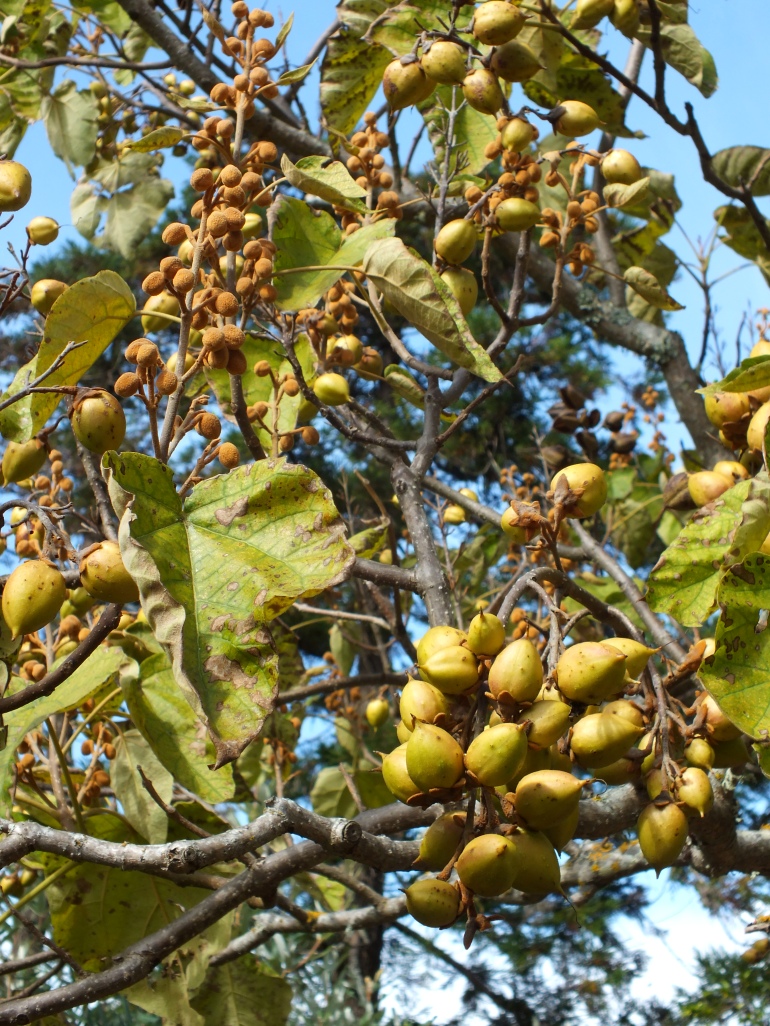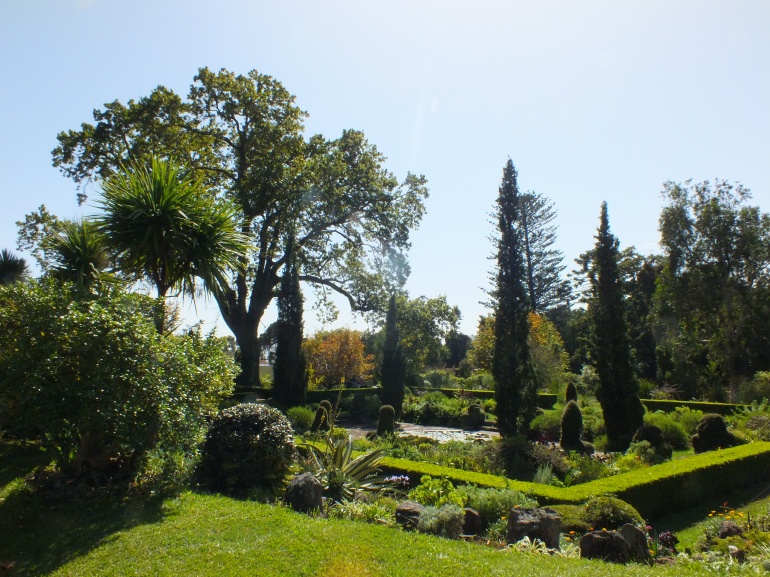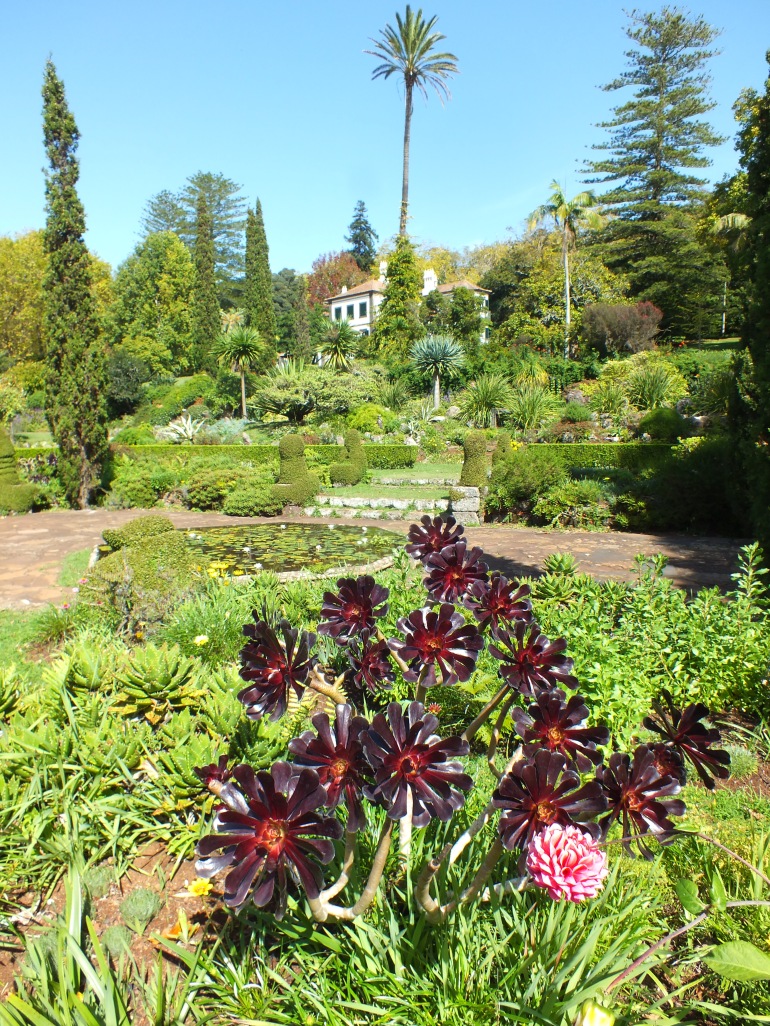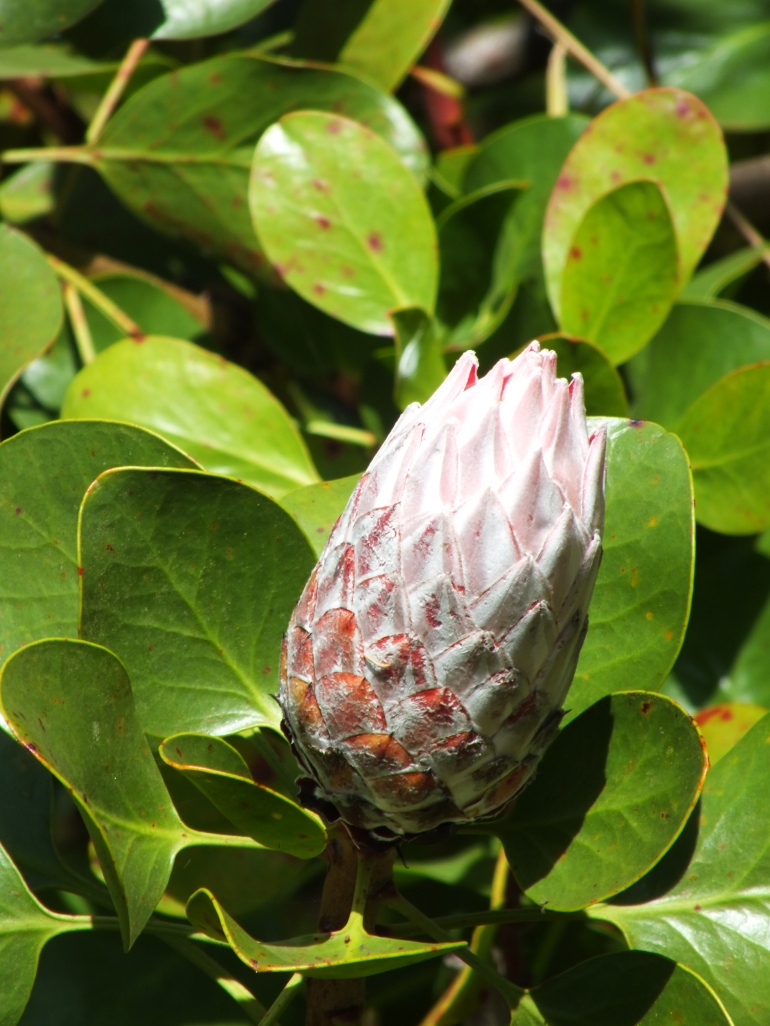 The gardens of Quinta da Palheiro are famous not only for the variety of plants that grow there but also for the beauty of their setting in the hills to the east of Funchal, the capital of Madeira.
The gardens of Quinta da Palheiro are famous not only for the variety of plants that grow there but also for the beauty of their setting in the hills to the east of Funchal, the capital of Madeira.
Madeira has long been called the Garden Isle and it seems that almost anything will grow in its fertile soils. In Funchal, many tropical plants have found a home and Hibiscus, Bougainvillaea are in flower almost all the year round along with Jacaranda, Spathodea, Erythrinas and Bauhinias in their season.
The Palheiro Gardens are situated in the Palheiro Estate at about 500 metres above sea level and while some of the more tropical plants are not so happy at this altitude, there is a great variety of plants that do well because the cooler air, often moistened by mist, encourages rapid growth. The original owner the first Conde de Carlvalhal, planted many trees on the estate and laid foundations for the camellia collection, some of its early tree planting from 200 years ago can still be seen today. The Quinta was acquired by the Blandy Family in 1885 and successive generations have devoted themselves to the gardens. The garden is a Mecca for Camellia lovers – the main flowering season from November to April. Typically English trees such as Oak, Beech, Cedar, Plane and Chestnut grow alongside Eucalpytus and Auraucaria pines. Outstanding specimens of Silver trees (Leucodendron argentum), Warratah (Telopia speciosissima) and members of the Proteaceae family are highlights in the gardens.
A tour of the garden
By the gatehouse, the lane lined with Plane Trees and huge Camellias forms the drive towards the gardens. On the left is a mass of Acacia (Mimosas) flowering in the early spring. The ground is carpeted with Agapanthus and Belladona lilies in their season (just going over now, in fact).
By the parking space are some Eucalyptus ficifolia, Paulownia tomentosa and various Magnolias. There is a huge Metrociderus excelsa. Heading through a grove of Cryptomeria japonica, edged by box, you enter the gardens.

To the left of the path is the Sunken Garden which is host to a brightly coloured flowers, including Gazanias, Lampranthus, Freesia, Ixias, Tritonias and Nerines. On the surrounding rockeries, there are various Agaves, Aloes, Dieramas, Aristeas, Aeoniums and many bulbous plants. Notable also the grass trees – Xanthorrhoea – which develop thick, fire-resisting trunks, hailing from Australia and which can live for hundreds of years.











Below the Magnolias and at the bottom of the garden are a number of different Banksias, the Australian cousins to the South African Proteas. Also fine examples of Camellia granthamiana from Hong Kong. Nearby is the very rare Sauraja subspinosa, a Burmese tree with delightful foliage and interesting pale pink flowers, red within, followed by handsome berries.






Leaving this area and heading towards the sweeping lawns, there is the chapel of St. John, built by Conde. A Baroque exterior belies a very simple interior. Look west below the chapel at the magnificent Aruacaria excelsa from Norfolk Island, an impressive flagpole, and the huge Araucaria bidwillii with its pineapple shaped cones.



Before going down the long border leading to the Jardim da Senhora, head back up to the north of the chapel to see a group of Proteas and allies; in this group is the beautiful Warratah, Telopea spinosissima, the exotic floral emblem of New South Wales, Australia. Here you will also find the new Rose Garden established in Spring 2007. The collection includes old-fashioned roses which grew elsewhere in the gardens and newer varieties – in particular David Austin varieties brought from the UK. The stones forming the centre-piece were part of Banger’s Pillar erected in 1798, once a landmark in Funchal and demolished in 1939 for the widening of the Avenido do Mar.







Returning to the Long Border, past more Camellias you will come to what looks like a traditional herbaceous border containing delphiniums and day-lilies, but also Brugmansias with their huge white, yellow, amber and orange trumpets, Blood Lilies (Sprekelia) and lots of different climbers.



The Jardim da Senhora, or Ladies Garden is set out in a more formal pattern with neat, clipped box hedging, though it is impossible to be too formal in this climate where growth is so rapid. Look out for Cantua buxifolia, Lagerstroemias, Clianthus, the Saint Helena ebony and the monarch of the gardens, a specimen of Araucaria angustifolia, the Candelabra tree from Brazil. Also worth mentioning, the Australian Jasmine Tree, Hymenosproum flavum.














Heading back from the long pond (and tea house) past the chapel, or along the various paths towards the lower parts of the main garden. Here there is a path leading to the Ribeiro do Inferno. This takes you past a terraced planting of Camellias to an area dank and dark and home to lovely tree ferns, Dicksonia antarctica. Leaving the Camellia avenue you will find, below the house, another group of Proteas, Leucodendrons, including Protea cynaroides, the King Protea, looking like a giant pink artichoke.









The text for the above notes has been taken, largely, from the booklet provided by the gardens, which might account for any stilted phrasing. Nevertheless it suited the purpose of guiding us around the gardens and linking my own photographs.
In my own words now –
Unlike the other gardens we visited in Madeira, which were steeply terraced and made the most of the views across the city and out to sea, these gardens are on a flat (-ish) hilltop site and while there is a gradual slope and broad terracing, the effect is altogether different to the Monte Palace Tropical Garden (which I loved) or indeed the Jardim Botanico (which I confess rather underwhelmed).
Parts are reminiscent of ~ an English Woodland, an avenue of mature London Plane trees, an English garden with broad lawns and traditional elements such as a herbaceous border, rose garden, sunken garden, camellia walk, ribbons of water. On closer inspection the variety of plants clearly takes us into the more exotic and their are bright, bright colours of both foliage and flower.
The views are mostly directed into the garden and individual elements are partly screened from their neighbours. Box hedging and topiary feature – though I have not seen a collection of topiary chickens before and certainly they would not be bedded out with Lewisias as they are here. The paths meander and cross, making the journey through the gardens more diverse and interesting – and while much might seem familiar – the elements of the garden are far more tropical than ever we could recreate here in the UK. Familiar and exotic, I very much liked these gardens.
A list of some of the plants represented in the gardens include –
Aeoniums, Agapanthus, Alberta magna, Aloe ciliata, Alsophilia spp, Amaryllis belladonna, Anigozanthus spp, Aristolochea gigantea, Araucaria angustifolia, Araucaria bidwillii, Araucaria cookii, Araucaria excelsa, Banksia spp, Beleperone guttata, Bletilla hyacinthina, Brugmansia arborea, Brugmansia sanguinea, Brugmansia versicolor, Burchelia capensis, Callistemon, Canarina canariensis, Cantua buxifolia, Ceanothus spp, Cedrus atlantica, Cedrus deodora, Cestrum spp, Clethra arborea, Clianthus alba, Clivia miniata, Colleta armata, Cornus capitata, Crinum morei, Dahlia imperialis, Davidia involucrata, Dicksonia antarctica, Dierama spp, Echium candicans, Eucalpytus ficifolia, Geranium maderense, Gladiolus spp, Haemanthus coccinea, Hedychiums, Hippeastrum spp, Hibiscus rosa-sinensis, Holmskoldia sanguinea, Hymenosporum flavum, Ixia viridiflora, Jacobina carnea, Lagerstromia indica, Leptospermum scoparium, Leucodendrum argenteum, Lomatia ferruginea, Lonicera hildenbrandiana, Magnolia spp, Melaleuca spp, Metrosideros spp, Michelia doltsopa, Michelia fuscata, Mina lobata, Moschosma riparium, Nerine sarniensis and spps, Nerium oleander, Ornithogalum thrysoides, Passiflora spp, Paulownia tomentosa, Pinus patula, Pittosporum coriaceum, Podocarpus spp, Polianthese, Polygala myrtifolia, Protea spp, Punicum granata, Puya alpestris, Quercus spp, Rosa spp, Romulea columnea, Russelia juncea, Salvia sessei, Salvia guarantica, Sarauja subspinosa, Sequoia sempervirens, Sequioa giganteum, Solanum wendlandii, Sparmannia africana, Sprekelia formosa, strelitzia nicoliae, Strelitzia reginae, Streptosolum jamesonii, Telopea spinosissima, Tibouchina semidecandra, Trachelospermum jasminoides, Tritonia croata, Trochotiopsis ebenus, Wachendorfia thrysiflora, Wigandia caracasana, Yucca whipplei
One or more links to follow, for more information on these interesting gardens –
http://www.palheirogardens.com/
http://www.gardenvisit.com/garden/quinta_do_palheiro_ferreiro
http://www.madeira-web.com/PagesUK/gardens/quinta-palheiro-ferreiro.html

